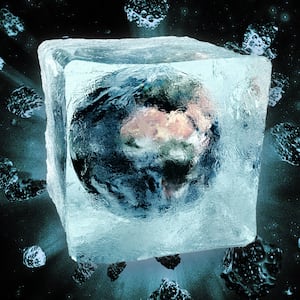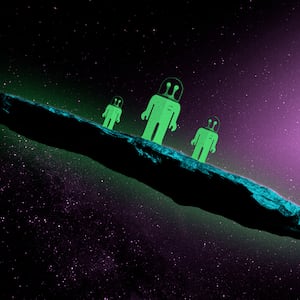Scientists consider it a matter of when, not if, an asteroid big enough to wipe out human civilization swings onto a collision course with Earth. That’s why these same scientists are working on methods of blowing up or nudging away this inevitable apocalyptic rock.
But these efforts might be a tad ironic. While a future giant space rock could very well end life on Earth, it’s possible a past giant space rock helped create life on Earth. That hypothetical Genesis rock is the subject of a new study from Nicholas Wogan, a University of Washington astrobiologist.
The asteroid, or several asteroids, may have mixed up Earth’s sterile, nitrogen-rich atmosphere—blending just the right elements in just the right mixture to kickstart a chemical chain reaction. This process lasted eons, and ultimately seeded the planet with the raw materials for life—most importantly, a crucial, life-seeding compound called hydrogen cyanide.
“Massive impacts are one of the only mechanisms for allowing Earth to have big concentrations of hydrogen cyanide in surface environments,” Wogan and his coauthors wrote in their peer-reviewed study, which has been accepted for publication at the Planetary Science Journal.
The possibility of a life-starting asteroid solves a problem that has been vexing astrobiologists for decades. We have a pretty good handle on what Earth’s atmosphere was like in the planet’s youth, billions of years ago. We also know what kind of atmosphere cradled those first scraps of RNA that ultimately evolved into bacteria, dandelions, fish, elephants, and—of course—people.
What we don’t know for sure is why Earth swapped a sterile atmosphere for one favoring biology. Something needed to boil the oceans, inject water and hydrogen into the air and add a healthy dose of methane so that these chemicals could combine into cyanide, which has “a very rich chemistry,” according to Nobel Prize-winning Harvard biologist Jack Szostak—and may have been the key ingredient in RNA and, therefore, life.
Broadly speaking, scientists agree there are two main possibilities: volcanoes and asteroids. But chemical analysis of very old rocks hints that early volcanoes produced a lot of nitrogen and carbon dioxide, but not a lot of methane, Wogan and his coauthors argued. Something else needed to inject the evolutionarily-necessary methane into the air.
That something else may have been one or a few well-timed huge asteroids. An iron-rich rock, potentially 300 miles across, would have exploded on Earth’s surface with the power of millions of atom bombs, kicking up unfathomable amounts of debris, or “ejecta.”
“Iron-rich impact ejecta could react with an impact-vaporized ocean,” the study’s authors explained.
The once nitrogen-rich atmosphere would become a hot water- and hydrogen-rich atmosphere with healthy streaks of carbon. As the air cooled over thousands of years, it rained methane into the newly reforming oceans. “Such a reducing atmosphere would have generated prebiotic molecules” such as hydrogen cyanide,” the study authors wrote. Prebiotic molecules are exactly what they sound like: the molecules that come just before biology in the evolutionary process.
The Genesis rocks are an elegant solution to the mystery of life’s origins, but that doesn’t mean they’re indisputable fact. Yes, one or more giant asteroid impacts would explain the methane rain that produced cyanide-flavored oceans that eventually bubbled up with single-cell organisms. But what if we’re wrong, and early evolution didn’t rely so much on cyanide? In that case, we don’t need asteroid impacts to explain how life came to be.
“A better understanding of the organic chemistry that led to life's origin would be helpful,” Wogan told The Daily Beast.
For now, asteroid-aided cyanide-based chemistry is a leading theory for explaining how a lifeless planet became a living one. It underlines one of the great paradoxes of evolution: the same forces that may have created life could also have destroyed it—and may yet do so in the future.
In their study, the authors stressed “how ‘lucky’ primitive life was if created by post-impact molecules, given a need to not be subsequently annihilated by further impactors.” One or a few big space rocks struck Earth in close succession and stirred up the air and oceans just enough. But one more big rock, striking right after the first organisms were beginning to flit around their shallow tidal pools, could’ve eliminated those same organisms. Evolution and global extinction, in close succession.
How lucky are we to even be here at all, considering how often giant asteroids seem to hit our planet? “That is very hard to answer,” Wogan said. “Some of the issues are that we don't know Earth's impact history very well around four billion years ago, and it is hard to know if a big impact would really sterilize the planet completely or not.”
Jonathan Itcovitz, a Cambridge astronomer, told The Daily Beast he’s an optimist. “Even if the necessary conditions [for evolution] are only provided at one in a million locations, and if only one in a million of those survive subsequent large impacts, there is still a chance that the chemistry can persist and flourish.”
Life, in other words, could find a way.
Wogan acknowledged it’s even possible that one asteroid kickstarted evolution only for another asteroid to cut it short—but then a third asteroid came along and started the process all over again, so on and so forth until life finally spread so far and wide that it got a lot harder to wipe out.
None of that means we should take our chances, of course. Just because our single-cell predecessors may have survived some truly apocalyptic asteroid impacts doesn’t mean we, as a technological civilization made mostly of meat and water, would also survive a direct hit from a giant space rock. We can be grateful that one major asteroid impact possibly propelled our evolution while also doing everything possible to prevent the next major asteroid impact.










